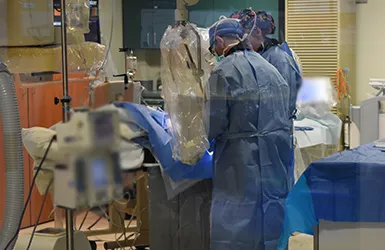Chesapeake Regional Performs First Robotic Assisted Vascular Procedure in the Region with Corindus Corpath GRX System
Patients with coronary artery disease now have access to new robotic-assisted technology that helps perform angioplasties to restore blood flow.
CHESAPEAKE – Chesapeake Regional Medical Center announced today the successful completion of the first robotic-assisted coronary angioplasty to take place in Hampton Roads. The hospital is also the first non-academic hospital in Virginia to perform the procedure using robotics. The procedure was performed by Ron McKechnie, M.D., an interventional cardiologist and Medical Director of the Cardiac Cath Lab at Chesapeake Regional Medical Center, using Corindus Vascular Robotics CorPath GRX System —the first and only FDA- cleared medical device to bring robotic-assisted precision to coronary angioplasty procedures while protecting medical professionals from radiation exposure occurring in hospital catheterization laboratories.
“The first case with the CorPath GRX System was very successful. Combining the enhanced visualization of the X-ray images with robotic precision will transform the way we perform angioplasty procedures and should ultimately improve patient care,” said Dr. McKechnie. “Sitting away from the X-ray source in a radiation-protected cockpit, I was able to use joysticks and touchscreen controls to advance the interventional devices, millimeter by millimeter, through the artery.”
Coronary artery disease (CAD), characterized by plaque buildup that restricts blood flow in the arteries, is a widespread and life-threatening condition. It is the most common form of heart disease and the leading cause of death in America.
Traditionally, percutaneous coronary intervention, commonly known as an ‘angioplasty,’ is the most common treatment for CAD, using a balloon to physically open a blocked artery to help improve blood flow. During an angioplasty, interventional cardiologists often use stents, a wire metal mesh tube, to prop open the artery and keep it open following the procedure. While angioplasty procedures remain one of the most frequently performed procedures in the United States, with approximately 900,000 cases annually, the procedure itself has remained largely unchanged for decades.
“An aging baby boomer population is driving demand for new, innovative technologies to treat CAD,” added Dr. McKechnie. “Vascular robotics offers physicians and patients a minimally invasive technology that improves the precision of stent and balloon placements and reduces radiation exposure during the procedure for patients and cath lab personnel.”
“We are proud to be the first medical center in Hampton Roads to launch a CorPath Vascular Robotic Program,” said Reese Jackson, President & CEO. “The adoption of the CorPath GRX System at Chesapeake Regional truly emphasizes our continuous commitment to delivering state of the art technology to our patients and clinical community.”
# # #
Chesapeake Regional Healthcare
Chesapeake Regional Healthcare is home to Chesapeake Regional Medical Center, the only independent, community-based hospital in the Hampton Roads region providing technologically advanced health care to the residents of southeastern Virginia and northeastern North Carolina. It offers a nationally accredited Chest Pain Center, a Bariatric Surgery Center of Excellence, four Women’s Choice Awards and one of the busiest Emergency Departments and maternity wards in the area. With more than 600 physicians and the first da Vinci® XI Surgical System in the state of Virginia, Chesapeake Regional is dedicated to putting patients first with the most advanced treatments in health care and a personalized touch. Website: www.chesapeakeregional.com
About Corindus Vascular Robotics, Inc.
Corindus Vascular Robotics, Inc. is a global technology leader in robotic-assisted vascular interventions. The company's CorPath® System is the first FDA-cleared medical device to bring robotic-assisted precision to percutaneous coronary and vascular procedures. With the CorPath System, Corindus Vascular Robotics brings robotic precision to interventional procedures to help optimize clinical outcomes and minimize the costs associated with complications of improper stent placement with manual procedures. For additional information, visit www.corindus.com, and follow @CorindusInc.
- Log in to post comments
